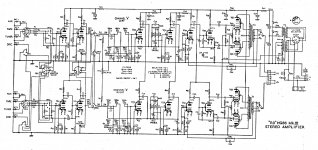Some thoughts 'bout this:
1st: The ECL84/PCL84 is a rather small tube, allowing only 4 watts of plate dissipation for the pentode. Not at all comparable to the PCL86's 9 watts.
2nd: The ECL80 is even tinier (3 watts plate dissipation limit) and has a combined cathode for both the triode and the pentode, which clearly limits it's application.
3rd: As insinuated before, after having displaced the PCL82 as a frame deflection tube, the PCL85 became a quasi standard in this application also in Europe, until having been replaced by it's successor PCL805.
4th: As also said before, the ECL86 has become a scarce and expensive tube today, due to it's limited production aera. So I see barely any use for it in new designs. The PCL86 is much cheaper - still.
Best regards!
1st: The ECL84/PCL84 is a rather small tube, allowing only 4 watts of plate dissipation for the pentode. Not at all comparable to the PCL86's 9 watts.
2nd: The ECL80 is even tinier (3 watts plate dissipation limit) and has a combined cathode for both the triode and the pentode, which clearly limits it's application.
3rd: As insinuated before, after having displaced the PCL82 as a frame deflection tube, the PCL85 became a quasi standard in this application also in Europe, until having been replaced by it's successor PCL805.
4th: As also said before, the ECL86 has become a scarce and expensive tube today, due to it's limited production aera. So I see barely any use for it in new designs. The PCL86 is much cheaper - still.
Best regards!
If you look only at the price of the tubes, ECL85 or the 6F3 China equivalent is the better choice now. I have built a ECL86 and a 6F3 single ended amplifier and they both work fine. The real issue with single ended is the price of the output transformer. There are plenty of cheap old 3W transformers from the '60 and modern China made replicas that fit the requirements of this kind of tubes. But if you want a good transformer, it costs almost the same as a bigger EL34 / 6L6 SE output transformer: at this point ECL / PCL based amplifiers aren't such a bargain anymore.
This output transformer is quite good and fair priced.
Will fit perfectly with ECL85 / 6F5P (sov.) and also has an UL-tap available.
TGL 5/001 INDEL - Transformer: speaker | TME - Electronic components
This in one or two classes higher grade:
TTG-EL84SE - Tube output UL transformer [5kOhm] EL84 / 6V6 SE - Shop Toroidy.pl
Will fit perfectly with ECL85 / 6F5P (sov.) and also has an UL-tap available.
TGL 5/001 INDEL - Transformer: speaker | TME - Electronic components
This in one or two classes higher grade:
TTG-EL84SE - Tube output UL transformer [5kOhm] EL84 / 6V6 SE - Shop Toroidy.pl
Last edited:
Good stuff!My Bedroom Clock Radio which wakes me up each morning is a programmable timer switching an old Sony Tuner into a Rogers Cadet III Amp driving Vintage Wharfdales which double as the bedside tables. The Cadet III runs ECL86 in push pull.
I'm still using my Rogers HG88 Mk III, which is the big brother to the Cadet Mk III, and I'm running it into vintage Wharfedale RS12DDs!
The push-pull ECL86s of the HG88 III run in fixed bias to produce 15+15 watts (+0/-1dB) at 1,000Hz.
Attachments
- Status
- This old topic is closed. If you want to reopen this topic, contact a moderator using the "Report Post" button.
